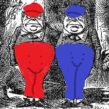by Karlos Bermann
Mercedes Hernández Morgan, known to her friends and neighbors simply as “Mercy,” lives in the barrio of La Marina, in the city of Cárdenas on Cuba’s northern coast. It’s a small city, with a population of around 136,000, the second city in the province of Matanzas, not far from the famous Varadero beach resort. The entire province of Matanzas was the center of a spike in Covid-19 cases in Cuba this summer, resulting from the worldwide spread of the highly contagious delta variant.
Mercy works in the neighborhood primary care clinic located a short distance from her home. She is also a delegate to the local council. She was at home on Sunday, July 11, talking with a colleague about a series of new measures to combat the virus, including a campaign to vaccinate the local population as quickly as possible with two of Cuba’s own Covid-19 vaccines—Abdala and Soberana 02. The vaccination campaign had stalled for lack of syringes. But thanks to syringe donations from several countries—among them Canada, Mexico, Russia, and the nonprofit Global Health Partners, as of August 1, three weeks after July 11, that campaign was showing progress: half the population of Matanzas had been fully vaccinated and new cases of the virus were starting to drop, even while they continued to rise in other parts of the country.
On July 11, Mercy and her co-workers were shocked to learn that a street demonstration was underway, with the demonstrators heading for the clinic where they worked. They had no experience of such things in Cuba, and this was during a pandemic! Nonetheless, they rushed out to join others from the neighborhood in forming a human barrier to protect the clinic. Some of the demonstrators shouted at them, calling names and chanting slogans against the Revolution. Then some began throwing things—stones, whatever loose objects were at hand. A young girl was in the street, exposed, trying to confront the demonstrators. Mercy ran to get her and bring her back to the relative safety of their line. Then Mercy’s face suddenly went numb, her vision clouded, as she put it later. When she touched the side of her head her hand came away covered with blood. Something—a rock or other object thrown by the demonstrators—had struck her in the head.
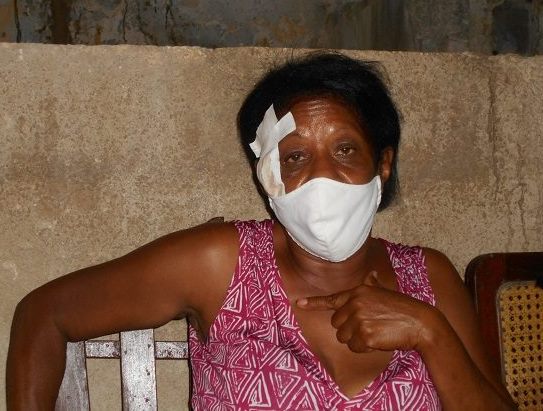
Police arrived and the demonstrators ran. Mercy was taken to the Cárdenas territorial hospital where the doctor stitched up a gash near her right eye and counseled her for possible concussion. Mercy was not the only casualty in Cárdenas that day. Several police were also injured confronting the demonstrators. Before the latter were done in the city they had overturned several cars and broken windows, including those of a gas station near Mercy’s clinic. They also looted a store in the neighborhood, taking beer and soft drinks, and broke into a nearby wholesale facility. The shelves were bare so they opened the cash register. When they found it empty, they threw it on the floor and smashed it. They even tried to assault the hospital where Mercy had been taken, pelting it with rocks. Some of the mothers who were there with their children ran inside to seek shelter, but others came out and held off the demonstrators until the police arrived.
In all, there may have been a few thousand demonstrators throughout Cuba on July 11. Their largest showing was a march along the Malecón—Havana’s waterfront drive—with perhaps 1,500. But many if not most of those were likely people who simply came out of curiosity, lured by vague or misleading social media posts. That march began peacefully. The police merely followed along and observed—until some in the march started overturning cars and throwing things, then the police moved in and began making arrests. But there were no bullets, no tasers, no teargas. One video did show a man in plain clothes using a small can of commercially available mace on a demonstrator who was resisting arrest. Elsewhere in the country the demonstrations didn’t exceed a few hundred.
Fake news
Newsweek magazine was one of the few US-based outlets to report on the disinformation campaigns launched from the US around the July 11 demonstrations. Those included reports that Raúl Castro, who had retired earlier in 2021 as head of Cuba’s Communist Party, had fled to Venezuela and that Venezuela was sending troops to Cuba. More significant, in terms of what sparked these “spontaneous” actions, Newsweek reported in its online edition of July 22, that thousands of new Twitter accounts with the #SOSCuba hashtag had been created in the days leading up to July 11. Between July 9 and July 11, robot accounts (“bots”) sent out over 2 million tweets and re-tweets promoting the demonstrations. It was clear that a large-scale campaign originating the the United States had played a major part in organizing and promoting the “spontaneous protests.”
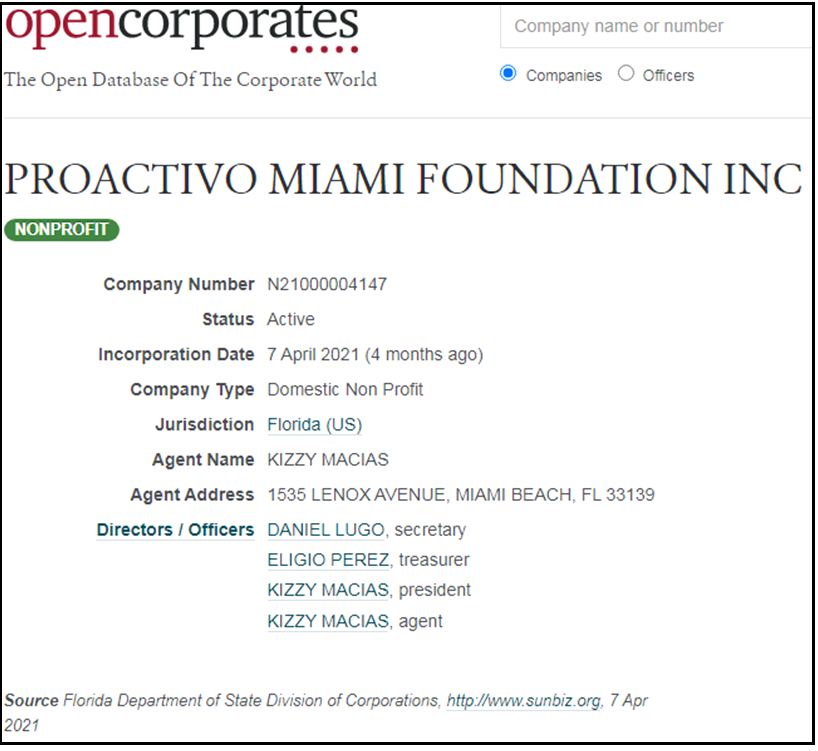
Venezuelan writer and Nobel Prize nominee Luis Britto García alleged in his July 31 Ultimas Noticias column that the bots were the work of an organization registered in Miami under the name Proactivo Miami Foundation Inc.[1] An internet search by this writer found that Proactivo Miami had been incorporated just three months prior to July 11. Based on their social media posts, its officers, two Cuban exiles and one Venezuelan exile, appear to be closely linked to the Miami Cuban exile community and to #SOSCuba. The Florida Cubans, in turn, have close ties to the “alt-right,” both directly and through such figures as Texas Senator Ted Cruz, Florida Governor Ron DeSantis, Florida Senators Marco Rubio and Rick Scott, and Miami mayor Francis Suarez. (The latter called for the US to intervene militarily in Cuba, even to bomb the island!) Among those taking part in Miami #SOSCuba events were the “Proud Boys.” In other words, many of the same people involved in or supporting the storming of Capitol Hill on January 6 were also involved in or close to the #SOSCuba destabilization campaign.
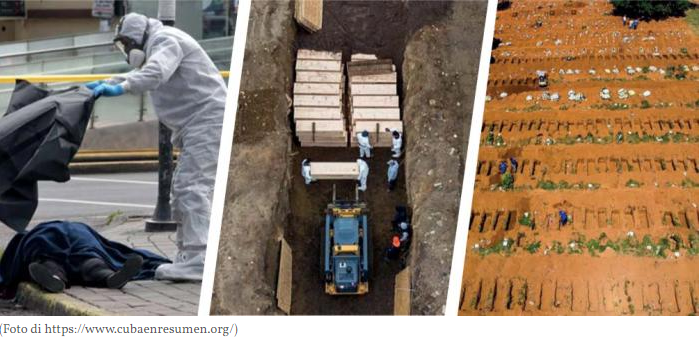

Repression or self-defense?
As to the “repressive” measures allegedly taken by Cuba after July 11, according to a statement by Joselin Sánchez Hidalgo, magistrate of the Supreme Popular Tribunal, as of August 5, 62 people had been tried in municipal courts for crimes connected with the July 11 demonstrations. All were charged with violations of the existing penal code for aggressive, violent, or damage-causing behavior. Fifty-three of those tried were found guilty of public disorder. Others were convicted of resisting arrest, contempt, and instigation to commit crime and damage. As reported, these crimes are subject to up to one year deprivation of liberty or a fine of 300 pesos, or both. Under Cuban law the defendants had the right to a lawyer and to present evidence and have the right to appeal. According to Magistrate Sánchez Hidalgo, one defendant was acquitted, while 22 were represented by a lawyer during the proceedings. Of those convicted, she said, 45 have appealed, and of those, 40 have engaged lawyers to represent them. The magistrate went on to note that the most serious cases arising from the events of July 11 are still under investigation and had not yet come to trial.[2]
Violent behavior
There are numerous graphic images documenting violent behavior by the July 11 demonstrators. Two of them are reproduced below. It appears that while the demonstrations in individual cities may have numbered in the hundreds, the violent riots with stone-throwing, arson, looting, and vandalism were the work of no more than a few dozen in each case. It appears that the majority of the participants—many of whom may have been no more than curious onlookers—dispersed as soon as the violence began. A strange fact about these demonstrations is that none of the published photos taken in Cuba on July 11 show participants with the signs, placards, or banners seen in anti-government demonstrations anywhere else in the world. Was this part of a plan to bring people into the streets under false pretenses, to be able to manipulate them? We can’t tell from the photos and videos what the participants wanted, although Washington, Miami, and the US media don’t hesitate to tell us. If we combine that circumstance with the fact that the actions were organized and promoted through social media amid a barrage of fake news, who can legitimately say why the majority of participants were there? Certainly they were tired of the pandemic, along with the rest of the world. Certainly they were suffering from the shortages of food, non-Covid medications, and other goods. But did they know they were taking part in “protests” intended to lead to the overthrow of the Cuban government and the Revolution? Did they know there were those among the participants who (apparently) had planned to resort to violence as a provocation in order to trigger repression in order to provide a pretext for a military intervention by the US, which the Miami exiles, including Miami mayor Sanchez, had called for?
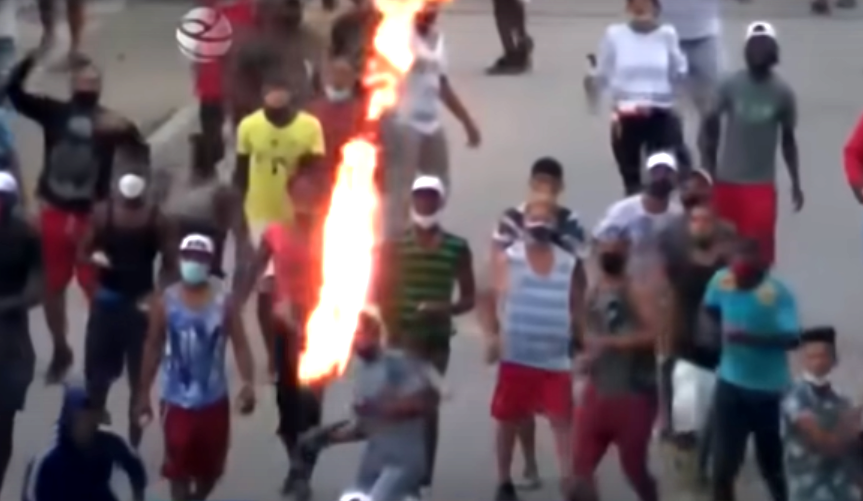

Given these provocations, intentional or otherwise, the response of the Cuban authorities was amazingly mild. Far milder than the response of police forces and National Guard in the US to the Black Lives Matter demonstrations. Or to other civil rights protests, the National Guard killing of four Kent State students in 1970, or the violent police repression of antiwar protesters at the Democratic Party convention in Chicago in 1968. Cuba is, after all, at war. It is not a war that Cuba has sought. It is a war imposed upon it by the world’s most powerful country, less than 100 miles away. Granted, it is not a shooting war—or hasn’t been since the Bay of Pigs. But it is a war, nevertheless, perhaps even more vicious, as it is meant to choke the Cubans into submission through the blockade, hostile action that seeks to de-legitimize the Cuban government by making its people suffer to the point where they will revolt. Cuba is under siege. No nation allows its citizens the “right” to disrupt or interfere with the measures necessary for its defense and survival when at war. They say truth is the first casualty of war. That is proven again every day in the US “soft” war against Cuba. Such being the case, perhaps we can say that free speech is the second casualty of war, and perhaps necessarily so. At least for the nation under attack.
Conditions in Cuba
Certainly there is discontent in Cuba, just as there is all over the world. The pandemic has been stressful for everyone, adding to and often multiplying other problems people have. In Cuba there were shortages of basic goods even before Covid-19, owing largely to the 62-year economic blockade imposed by the US. Then the pandemic cut off tourism, one of Cuba’s leading sources of the hard currency needed to pay for imports. Meanwhile domestic production, including foodstuffs, was severely impacted by restrictions on internal travel and transportation imposed to block the spread of the virus.
Through most of 2020, Cuba maintained low rates of Covid infection and transmission as well as a very low rate of mortality. But in 2021, with the loosening of some restrictions, the delta variant arrived—a situation occurring all around the world, including in the United States. At the same time, early in 2021 Cuba began introducing needed economic reforms. One of the most significant of these was unification of the dual-tier monetary system, which included a convertible peso, officially pegged to and on par with the US dollar, alongside a domestic peso, with which Cubans were paid. The latter was supposed to be tied to the convertible peso at a rate of 25:1, but it could only be used to pay for domestic products and services. Most Cubans didn’t have access to the convertible peso, or to dollars, except for those receiving remissions from Cubans living abroad. They were therefore unable to shop in the hard currency stores that sold imported goods.
Conversion to a single currency required other changes, including adjustment of wages and prices. The conversion process, which is still underway, has caused disruptions and dislocations, as things get re-adjusted and corrected. All of this, while necessary, came at a bad time. And to make things worse, the United States created new obstacles for the Cuban banking system to exchange dollars. As a result, the value of the new peso is now being quoted in euros instead of dollars. So, for the time being it is one more headache for Cubans.
Another major part of the reform was to open most branches of the economy to private enterprise. Small and medium entrepreneurs will be able to employ up to 100 workers, and to share ownership with those living outside the country. It is hoped that this will alleviate many if not all of the shortages and provide Cubans with a wider range of consumer goods. People living on the island won’t see the benefits of that right away, however.
Who is the principal human rights violator in Cuba?
No serious discussion of human rights violations on the island of Cuba can take place without consideration of the 40 prisoners held virtually incommunicado for nearly twenty years—the majority of them without trial, without so much as a charge being filed against them. I refer to the prisoners in the “detention center” at the Guantánamo Naval Base, the part of Cuba occupied by the United States since 1898.
The Guantánamo detention camp
On January 11, 2021, the 19th anniversary of the establishment of the Guantánamo Bay detention center, a panel of experts from the United Nations Human Rights Commission released a statement appealing to the incoming Biden Administration to immediately close the internment camp. They said the remaining detainees risked death from deteriorating health and the mental and physical harm suffered in cruel and inhuman conditions of imprisonment. “Guantánamo is a place of arbitrariness and abuse, a site where torture and ill-treatment was rampant and remains institutionalised, where the rule of law is effectively suspended, and where justice is denied,” the experts said, adding that the Covid-19 pandemic had further worsened the health vulnerabilities of the now elderly prison inmates. “The very existence of this facility is a disgrace for the United States and the international community as a whole. Guantánamo should have been closed a long time ago,” the statement concluded.[3]
As to the legality of these detentions under international law, the following is an excerpt from the abstract of a paper published in the Journal of International Criminal Justice:
Those persons who were arrested in Afghanistan are protected by IHL [International Humanitarian Law] of international armed conflicts. In such conflicts, there are two categories of ‘protected persons’: combatants, who become prisoners of war protected by the Third Geneva Convention if they fall into the power of the enemy; and civilians protected by the Fourth Geneva Convention when in enemy hands. The US administration claims that the persons it holds in Guantánamo are neither combatants nor civilians, but ‘unlawful combatants’. However, no one can fall in between the two aforementioned Conventions and therefore be protected by neither of the two. There are good reasons to consider the captured Taliban as prisoners of war. As for the al Qaeda members captured in Afghanistan, it may be justified to deny them prisoner of war status, on a number of legal grounds. However, as protected civilians, they may not be deported to Guantánamo, but may be detained in Afghanistan for the prosecution and punishment of criminal offences (including for having directly participated in hostilities); or they may be interned for imperative security reasons, upon individual decision made in a regular procedure which must include a right of appeal.[4]
In other words, the detentions at Guantánamo, at least insofar as those seized in Afghanistan are concerned, were and are illegal. In short, they constitute war crimes.
The pandemic
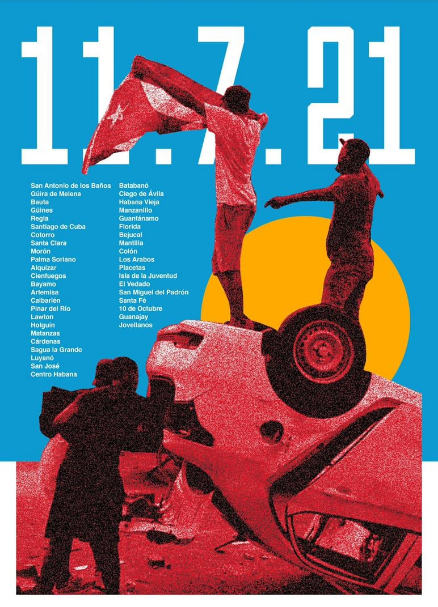
The Cuban exiles claimed that their #SOSCuba campaign was in response to the Cuban government’s alleged failure to adequately address the Covid-19 pandemic. Since most of them are located or based in Florida, it would seem reasonable to compare the Covid-19 statistics for Cuba with those of Florida. There are after all, a lot of people traveling back and forth between Florida and Cuba, and that traffic has never stopped completely, even with the pandemic and the obstacles the US government has placed in the way of any intercourse. Here, then, are the statistics:

Put simply, Florida has had 2.25 times as many Covid-19 cases per 100k inhabitants, and nearly 4 times as many deaths! One might say you can’t make such comparisons. I disagree. Taking into account the vast wealth of Florida compared to Cuba, and the freely available medical and protective equipment Florida had at its disposal after the first few months of the pandemic, the differences are all the more glaring in favor of Cuba. The latter, after all, had to manufacture its own ventilators, and thanks to the US economic blockade, halt or slow its vaccination campaign (with its own vaccines) at various points while awaiting donations of syringes and other necessary equipment from China, Russia, Mexico, Canada, and other countries, plus the nonprofit Global Health Partners. Joe Biden, current front man for the US foreign policy establishment, called Cuba a “failed state” (CNN, July 16, 2021). If we are to take the Covid-19 statistics as the measure, it would appear that Florida, not Cuba, is the failed state.
What the Tokyo Olympics demonstrated
While we’re on statistics, the “2020” Summer Olympics (actually held in 2021) recently concluded in Tokyo. In terms of medal score, Cuba finished 14th out of the more than 200 countries competing, ahead of all the other nations of Latin America or the Caribbean except Brazil. Cuba had won 226 Olympic medals prior to Tokyo, far more than any country in Latin America or the Caribbean, Brazil included, the vast majority of them since the Revolution of 1959. That record can not be understood apart from the improvements in public health achieved since the Revolution. That is to say, since Cuba ceased being “the Brothel of the Caribbean” as it was known during the United States tutelage in effect from 1898 to 1959. Those are hardly indicators of a “failed state,” notwithstanding all of Washington’s efforts to make it fail.
Since the Revolution, Cuba has made great strides not only in health care but in pharmaceutical and biomedical research. Health statistics for Cuba’s population are on par with those of the world’s wealthiest countries. Cuba even beats the US in life expectancy and a lower rate of infant mortality. Its pharmaceuticals are used around the world. From the very beginning of the pandemic, Cuba has sent “brigades” of doctors, nurses, and other medical personnel to help dozens of countries in Latin America, Africa, and Asia—even Europe (Italy and Andorra). This was a continuation, on a larger scale, of efforts Cuba made during previous epidemics. Through both the Trump regime and now Biden, Washington has cynically tried to smear Cuba’s aid efforts, claiming the medical personal are “slave labor,” whose earnings are taken to support the “dictatorship.” The US tried to pressure the recipient countries into sending the Cubans home. For the most part, the campaign fell on deaf ears. Its only successes were in Brazil, Ecuador, and Bolivia, whose right-wing governments were cozying up to Trump.
The house-broken US media has parroted the slave labor charges, making no effort to fact-check them. Had they done so, they would have found the following: All personnel on these brigades are volunteers. In fact, there’s a waiting list to get on them. Why? Are the Cubans really that self-sacrificing? Cubans, like people everywhere, do things for a mix of reasons. Yes, they are instilled with ideals of internationalism. But the participants in these brigades, while not paid anything like the salaries of the rich countries, earn more than their regular income in Cuba. Even more important, during their stay in countries not blockaded by the US, they have access to the whole gamut of consumer goods that aren’t available in Cuba, and these they can bring or send home to their families. The Cuban government charges the host governments for this aid based on what they can afford to pay. No, they don’t distribute all of it to the medical workers. Unlike their counterparts in the US, Cuban doctors and other medical personnel don’t graduate from school with hundreds of thousands of dollars in student debt. All education in Cuba, including medical school, is free to them. It is not free to the Cuban government, however.
What has the US achieved?
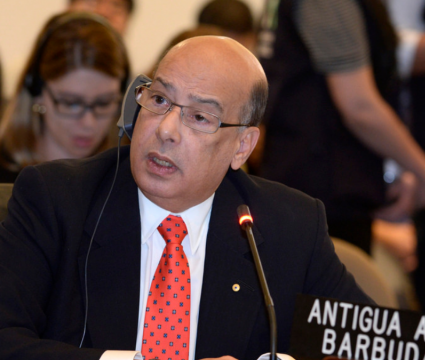
Washington’s campaign to discredit Cuban medical assistance has gained little traction outside the United States. Thus far its propaganda around the events of July 11 has been echoed by anti-Cuban media in a number of countries, but has otherwise been a flop. One example was the attempt to call an extraordinary meeting of the Organization of American States (OAS) to discuss the Cuban situation. The following is excerpted from an editorial by Sir Ronald Sanders, Coordinator of CARICOM, the association of Caribbean states, and also the ambassador to the US from Antigua and Barbuda. The editorial, titled “Using the OAS to promote discord over Cuba,” appeared in the July 30 edition of the Antigua and Barbuda Observer. Sir Ronald noted that the meeting had been called with less than 48 hours’ notice by the current (temporary) OAS chair, Abdala Washington of Uruguay.
“A sudden, unexplained decision to discuss Cuba in the Permanent Council troubled member states who could see no productive outcome from it. Indeed, if anything, such a discussion was considered to be harmful to diplomatic efforts to try to improve relations between the US and Cuba which was one of President Biden’s undertakings during his campaign to be elected President,” Sir Ronald wrote. He continued:
Further, on the same day that the Chair of the OAS Permanent Council issued his unexpected convocation of the meeting to discuss Cuba, CARICOM Heads of Government had written to President Biden saying that they were “troubled by the circumstances in Cuba,” referring to protests that had taken place on July 11. They attributed the protests to the 61-year-old US trade embargo, punitive measures imposed by the Trump administration, and the effects of the Covid-19 pandemic. They said, “All of this, together with threats to its national security, have contributed to placing Cuba in conditions of abnormality in which normal criteria and expectation cannot be applied.” They called on President Biden to lift the embargo “so that all the rights to which the Cuban state and its people are entitled can be respected and upheld,” and they recalled that “under a previous US administration of which you were a part, significant strides were made in this direction, and could be advanced to beneficial effect.”
Sir Ronald then went on to detail the curious—not to say suspicious—way in which the call for the OAS meeting had come about:
Passing strange was an email sent to many OAS delegations by an Organisation called “Youth and Democracy in the Americas,” formed by Venezuelan nationals with help from the OAS Secretary-General, Luis Almagro. Curiously, this organisation told OAS Ambassadors on 27 July that it had “presented a petition to the Secretary General of the Organisation of American States (OAS), Dr. Luis Almagro, and subsequently our President Cecilia Navas [of the youth group] met with the President of the Permanent Council of the OAS and also Uruguayan Ambassador, Washington Abdala, to request a [sic] extraordinary session to discuss the serious humanitarian situation suffered by our Cuban brothers and sisters, and the dangers facing democracy in the Republic of Cuba” . . . It was evident from this email message that the Chair of the Permanent Council and the Secretary-General had accepted and consulted with an external group that has a specific political agenda, and not with member states of the OAS on the holding of a meeting to discuss Cuba. A very odd way to behave, causing more questions to be raised, concerning the motives for the meeting.[5]
Thirteen of CARICOM’s fifteen full-member states sent letters opposing the special OAS meeting. Many Latin American countries joined them. The meeting was ignominiously shelved.
Embargo or blockade?
Spokespersons for US policy often claim that the trade embargo is not a blockade because it only affects businesses or persons in the United States. Commentators for the major media outlets have dutifully repeated the official line, all the while downplaying and minimizing it as a cause for Cuba’s economic difficulties. But that is a lie (not to put too fine a point on it) that is easily verified. One has only to consult TradeWinds, the global journal for shipping news: “US-Cuba lawsuits show no signs of slowing down as Maersk sued,” reads a headline from February 27, 2021. “Following actions against cruise lines and US-based firms, the Danish containership giant is the latest shipping company to be hit with a lawsuit under the Helms-Burton Act, passed in 1996 and designed to strengthen the ongoing US blockade against Cuba,” TradeWinds explained. And on August 9, 2021: “CMA CGM latest shipping company targeted over Cuba dealing. French liner giant routed cargoes to Cuba via Jamaica in addition to maintaining warehouse facilities there.”[6] These are major European companies, being sued or threatened with lawsuits for involvement in Cuban trade. They risk seizure of any assets they may have in the United States, or of their ships and cargoes that enter US waters. As a result, the normal shipping channels of world trade are closed to Cuba, which must resort to workarounds that make importing or exporting much more difficult and expensive.
There has been a great deal of discussion on the legality of the Helms-Burton Act. Christian Franken, for example, wrote in the Minnesota Journal of International Law, “U.S. trading partners claim that the Act violates their sovereignty by exposing their citizens to the extraterritorial application of American law. Critics also assert that [Helms-Burton] breaches trade agreements, particularly the General Agreement on Tariffs and Trade (GATT) and the North American Free Trade Agreement (NAFTA), by restricting access to the U.S. domestic market.”[7] Unfortunately, such discussion of law is moot. The United States considers itself above the law, a law unto itself.
Despite all the noise around July 11, the US campaign to destabilize Cuba didn’t work. Cuba is stable and moving forward notwithstanding all the propaganda and all the obstacles Washington has tried to put in its way. That is not to say that the immediate future will be easy. At the United Nations the world has voted overwhelmingly time after time to condemn the blockade, but without far more serious pressure from abroad Washington is not going to give it up. For the foreseeable future the blockade will be a fact of life.
But Cuba now has a handle on the corona virus. The vaccination campaign is ramping up. For

the week ending August 27, new cases dropped significantly. Cuba is already beginning to export its vaccines. It will come out of this long tunnel with its prestige greatly enhanced. Oddly enough, the destabilization campaign may have backfired. Aid in the form of food and medical supplies from Cuba’s many friends has been pouring in since July 11, both from govern-ments and non-governmental solidarity and humanitarian aid groups. On September 4, Cuba announced that from the inter-national aid received it had already distributed, free of charge to the recipients, nearly 2 million food baskets containing several pounds each of rice, lentils and pasta, as well as sugar. Locally, these are being supplemented with additional products that have arrived in lesser quantities, such as canned meat, tuna, and cooking oil. And on August 21, BioCubaFarma, the Cuban biotechnology and pharmaceutical industry group, announced that thanks to recent arrivals of inputs from abroad, 251 of the 359 non-Covid pharmaceuticals manufactured in Cuba were now back in production, with the remainder expected by the end of the year.[8]

Who is really driving the campaign against Cuba?
Behind the façade of the Washington politicians—the president, vice-president, the Congress—is a permanent, non-public government. It includes the foreign policy and national security establishment—the State Department, Pentagon, CIA, NSA, along with seemingly innocuous agencies like the Agency for International Development (USAID). Behind those is a host of think-tanks whose members craft policies, advise those who nominally hold the power, and rotate in and out of government themselves. This is the shadow government that directed the US intervention in Vietnam through five presidents and millions of dead, from the end of World War II to its infamous climax in 1975 with the fall of Saigon. It directed the intervention in Central Asia, working with and through Pakistan to arm, fund, and train mujahideen to fight the Soviet supported government in Afghanistan. After the Soviet withdrawal in 1989 there came a decade of civil war between various factions of the mujahideen. It was from those groups that al-Qaeda and the Taliban emerged, with the latter taking power in Afghanistan in 1996. That, in turn, led to 9/11, to the US invasion of Afghanistan in 2001, and the establishment of a weak, corrupt, and unpopular US client regime, which billions of dollars and as many as 140,000 US troops (with token contingents from US allies) over 20 years could not keep in power. That same shadow government plotted the invasion of Iraq under the false, trumped up pretext that Saddam Hussein was building weapons of mass destruction. And the final chapter of US imperial involvement in Iraq has yet to be written. It was their policies that came to fruition with the collapse of the US created regime in Afghanistan and, amid the mad scramble to evacuate US personnel and their Afghan employees from the Kabul airport, the return of the Taliban to power. That shadow government is the machinery of imperialism. It is now aimed at Cuba.
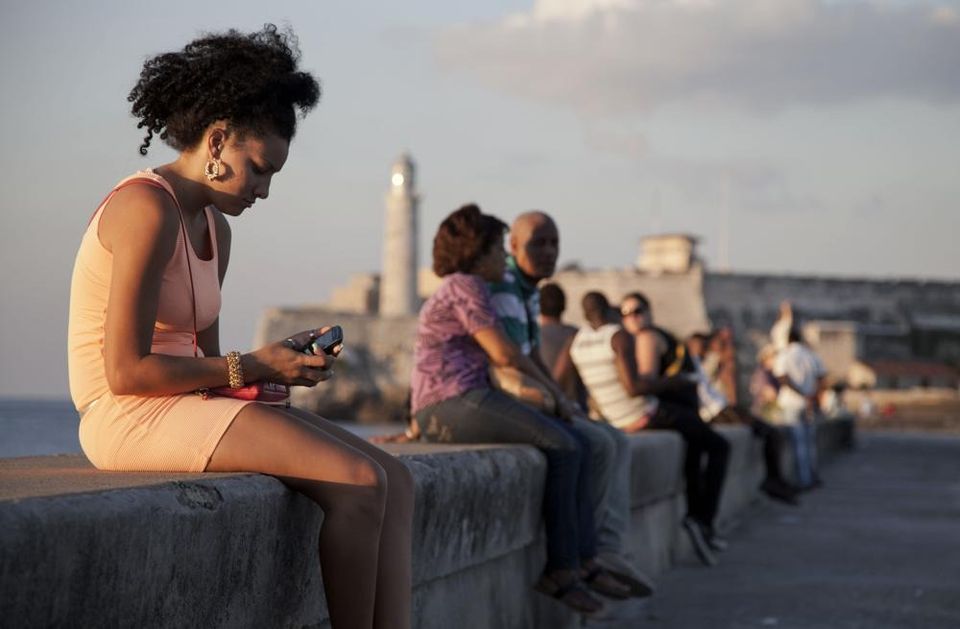
The many-headed monster of “national security” has apparently convinced itself that, given all its power and resources, the only plausible explanation for its failure to return Cuba to its pre-1959 neo-colonial status was some super-human ability possessed by Fidel and Raúl Castro to mesmerize the Cuban people. But now, they reason, with Fidel dead and Raúl retired, the Cuban government must be ready to collapse. All it would take would be a disinformation/destabilization campaign using the intermediary of the exile groups they were already financing. The Bay of Pigs on a larger scale, with the help of the internet and the “social media” virus it has spawned. It is just the sort of (wishful) thinking you get when a collection of corporate executives, Ivy League elitists, and National Security careerists believe in their own infallibility and omnipotence. People who have little or no knowledge of the real world, of the countries they’re trying to control, and no interest or incentive to get that knowledge. People lacking any conception of the real meaning of revolution. It is such ignorance, ideological blindness, and imperial arrogance that guided the United States into the catastrophes in Vietnam, the original Bay of Pigs, and now the ignominious end in Afghanistan.
Since the end of World War II, the United States has sought to control the globe. To “contain” those of its perceived enemies who were, for the moment anyhow, too strong to defeat or overthrow, and to impose its will on the rest. That’s not to say that such imperial ambitions began in 1945. They did not. The United States had its “coming out” as an imperialist power in the Spanish-American War of 1898, and the roots of US imperialism go back a century before that, to the westward and southward expansion, and to the Monroe Doctrine, even though the driving forces of empire may have been somewhat different at the outset.
With victory in the Spanish-American War, the US took possession of Cuba, Puerto Rico, and the Philippines. During the early 20th Century, it solidified its control over the Caribbean Basin by sending the Marines into Panamá, Nicaragua, Haiti, and the Dominican Republic. Those occupations produced the dictatorial regimes of the Somozas in Nicaragua, François Duvalier in Haiti, and Rafael Trujillo in the Dominican Republic. And when the US relinquished formal control of Cuba in 1934, it left behind, or had created the conditions for, the Machado and Batista dictatorships. The same pattern repeated itself in the Philippines with the dictatorship of Ferdinand Marcos.
In 1953, the CIA engineered a coup in Iran that overthrew the nationalist Mossadegh government and put in power the shah, Reza Pahlavi, another hated dictator. 1953 was a big year for imperialism made in USA. The US was then already secretly supporting the French against the Viet Minh who were fighting for a free Vietnam. In 1954, the Viet Minh decisively defeated the French at the battle of Dien Bien Phu, where CIA personnel were present as advisors to the French. The US then took part in drafting, but did not sign, the Geneva Accords later that year. Those provided for the temporary partition of Vietnam into North and South, with elections to reunify the country to be held in 1956. But in 1956 South Vietnamese dictator Ngo Dinh Diem, with US backing, refused to hold elections, and so began the Vietnam War. But in the end, 19 years later, even a force of over 550,000 US troops could not keep the regime of Diem and his successors from collapse. Also in 1953, the CIA overthrew Jacobo Arbenz, the elected president of Guatemala. Twelve years later US troops invaded the Dominican Republic once again, after the Dominican people had thrown out Trujillo, in order to prevent “another Cuba.” Then came the island of Grenada in 1983 and Panamá again in 1989, under various pretexts, but always for the real purpose of “regime change”—removing governments Washington didn’t like and picking figureheads that would do Washington’s bidding.

Can Joe, the resurrected Cold Warrior, win votes from right-wing Republicans in Florida?
The Biden Doctrine
We could point out the irony of Joe Biden trying to cozy up to the #SOSCuba gang, which includes the Proud Boys, Ted Cruz, Ron De Santis and the others–many of the same people who tried to overturn his own election. But the whole concept of irony, of hypocrisy, is lost upon Biden and Blinken and Jen Psaki, just as it is upon the real powers-that-be in Washington. For them, truth, fact, what they said or did yesterday, is irrelevant. It’s all about whatever works, whatever story line or “spin” they can use to get them closer to their objective of the moment, whether it’s getting elected, overthrowing a government, or jockeying for world power. Republicans or Democrats, it’s all the same. It doesn’t matter whether there are or are not human rights violations in Cuba. If they want to overthrow the Cuban government and can’t find any human rights violations sufficiently egregious, they’ll invent some. Just as, when they need a cat’s paw in the Middle East, Israel will be a nation of Holocaust survivors just trying to peacefully live out their lives in a sea of murderous Arabs, not the Israel that engages in ethnic cleansing in the occupied territories or practices apartheid within the Zionist state itself. Nor does Saudi Arabia’s grisly murder of Jamal Khashoggi count, or its genocide in Yemen, or whether the oil kingdom conducts public beheadings. All that will be denied or prettied up to suit the needs of politics, of Capitalism and Empire, as they did this month, September 2021, in giving more in military aid to the Egyptian dictatorship than even Trump gave. Unless they are applied equally and evenly all across the globe, and by some authority that is truly unbiased and has no ax to grind, the “human rights” claptrap is nothing more than a political tool. Let him who is without sin cast the first stone.
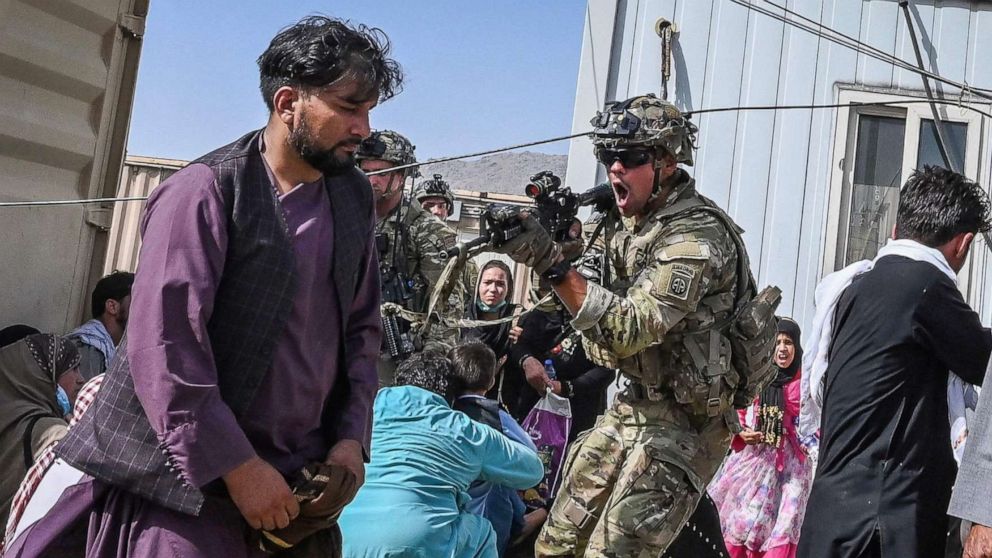
When Biden talks about ending “forever wars,” what he really has in mind is ending wars where “American boys” (and now “girls”) are in harm’s way, getting shot at or blown up, killed and maimed, thus generating popular opposition at home. What he and the Washington foreign policy/national security bureaucracy have in mind is forever wars by proxy and remote control: secret armies of foreign mercenaries (the CIA’s long-time stock-in-trade); technicians in Colorado, video gaming with drones to kill real people and blow things up in the Middle East or elsewhere while they have their morning coffee; missile strikes from the safety of US ships stationed hundreds or even thousands of miles away; manipulating the internet and social media to orchestrate social upheaval and destabilization in countries like Cuba. But it won’t work. Not against determined opponents, no more than the carpet bombing of Vietnam with high-altitude B-52 bombers (in America’s other forever war) could stop Vietnamese determined to shake off colonialism.
Failed state?
If Cuba were truly a “failed state” and “communism” a “universally failed system” as Biden claimed, it would only be logical to drop the economic blockade. There would be nothing to lose, and everything to gain: the blockade would then no longer mask Cuba’s alleged failures. But of course logic doesn’t enter into the equation, nor does truth, or reality for that matter. What Washington fears is that Cuba is not a failed state at all. It keeps its boot on Cuba’s neck hoping that after nearly 62 years it can make Cuba fail at last. And of course Biden can’t lift the boot because—talk about delusion!—he’s campaigning for Florida’s Cuban exile votes in the next election.
The US will not strangle Cuba, even though, sad to say, the blockade will likely continue, the political system in the US being what it is. Joe Biden may gain a few political points by manipulating the suffering of the Cuban people. But as Cuba showed the world in Tokyo, where it dominated the boxing competition, it punches well above its weight. Cuba will absorb the punches of Trump-Biden and the Washington bureaucracy; it will absorb the punches of Covid-19. It is not on the ropes, it is not out of breath. It is far from out.
Notes
- https://ultimasnoticias.com.ve/noticias/opinion/con-cuba-luis-britto-garcia/ [Return to text]
- http://www.guerrillero.cu/asi-marchan-las-investigaciones-penales-tras-los-sucesos-del-11-de-julio-en-cuba/ [Return to text]
- https://www.ohchr.org/EN/NewsEvents/Pages/DisplayNews.aspx?NewsID=26649 [Return to text]
- Marco Sassòli, “The Status of Persons Held in Guantánamo under International Humanitarian Law,” Journal of International Criminal Justice, Volume 2, Issue 1, March 2004, Pages 96–106, (https://doi.org/10.1093/jicj/2.1.96) [Return to text]
- Sir Ronald Sanders, “Using the OAS to promote discord over Cuba,” https://antiguaobserver.com/using-the-oas-to-promote-discord-over-cuba/ [Return to text]
- https://www.tradewindsnews.com/law/us-cuba-lawsuits-show-no-signs-of-slowing-down-as-maersk-sued/2-1-967900; https://www.tradewindsnews.com/law/cma-cgm-latest-shipping-company-targeted-over-cuba-dealings/2-1-1048952 [Return to text]
- Christian Franken, “The Helms-Burton Act: Force or Folly of the World’s Leader,” https://scholarship.law.umn.edu/cgi/viewcontent.cgi?article=1162&context=mjil [Return to text]
- https://www.cadenagramonte.cu/english/show/articles/33352:cuba-gradually-resumes-production-of-oral-antibiotics [Return to text]
